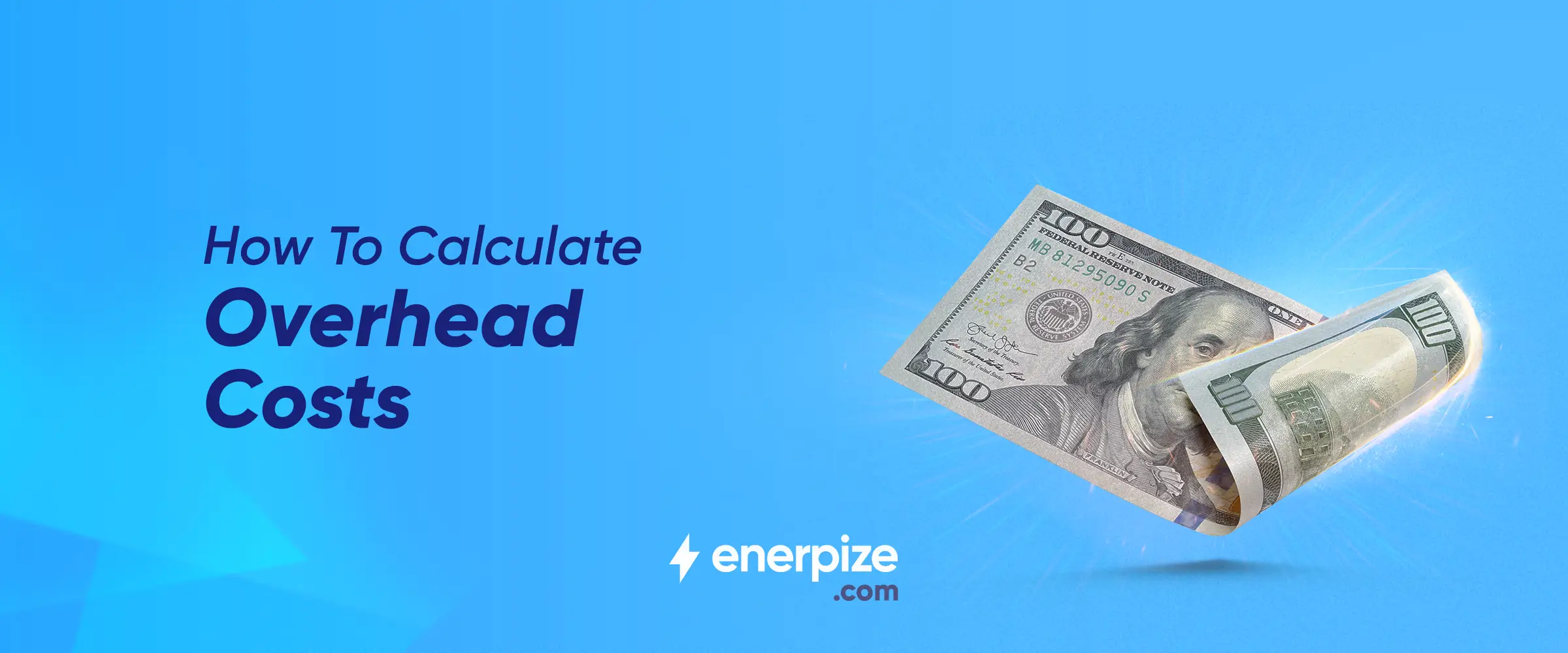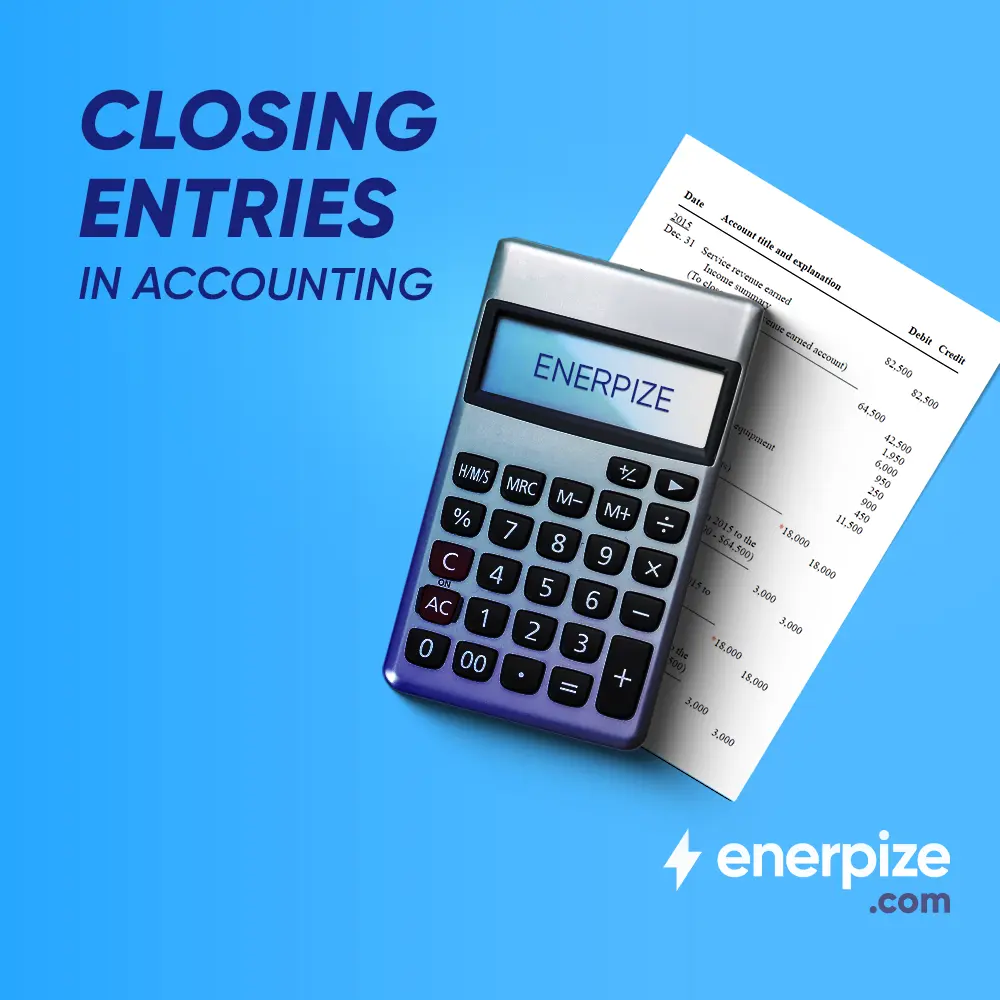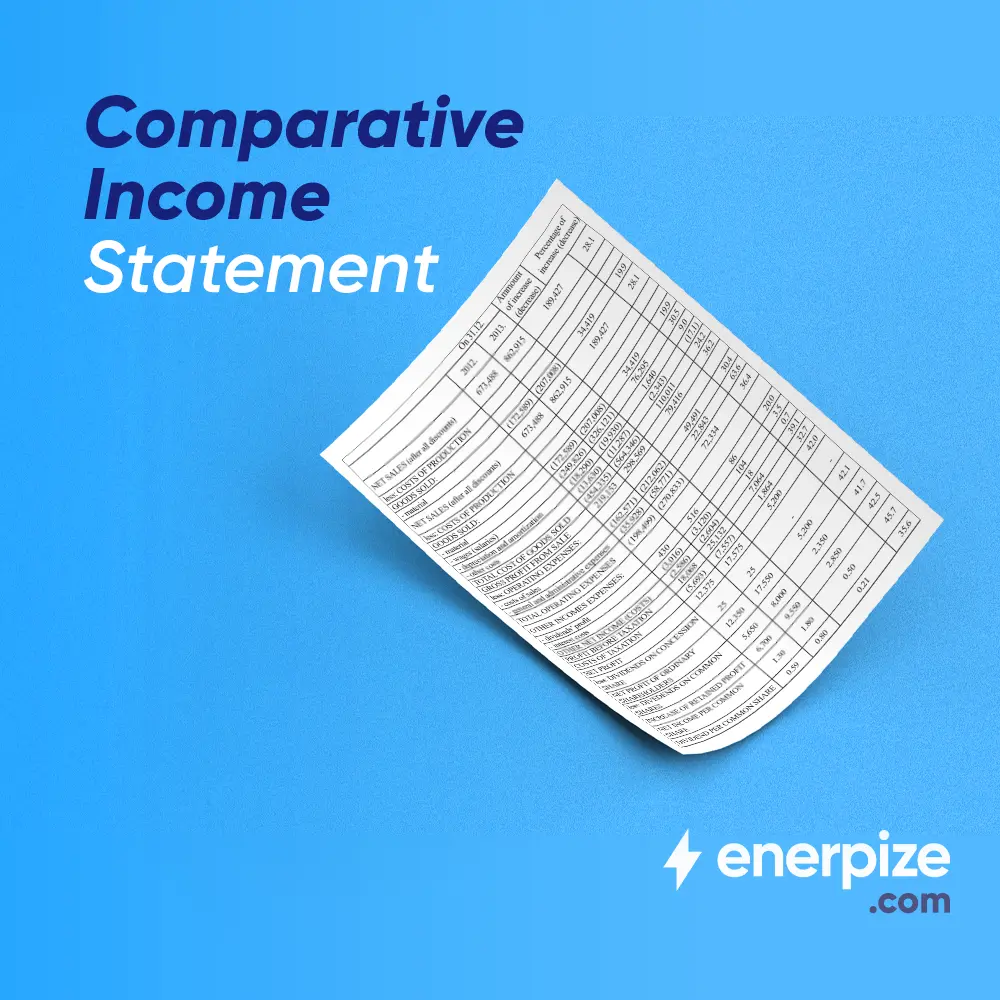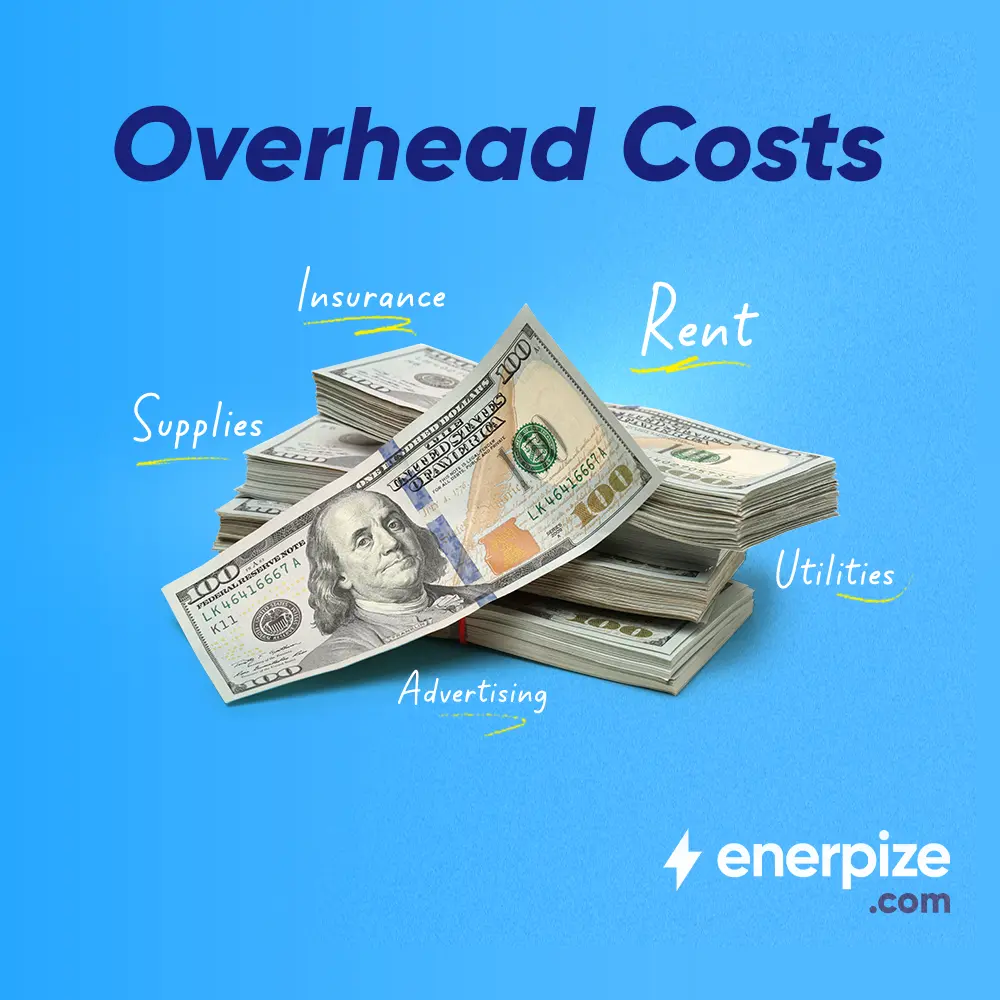Author : Enerpize Team
Overhead Cost Calculation: Formula and Examples

Cost accounting involves a wide range of revenue and expense calculations. Overhead costs, usually downplayed in business expense accounting, could be crucial for business survival.
As your business grows, so do your expenses. If you do not manage your overhead costs properly during your growth journey, you may encounter cost hiccups, unpleasant regulatory surprises, and business disruptions.
The risks you run into if you do not manage your overhead costs properly also include:
- Reduced profitability.
- Decreased efficiency.
- Competitive disadvantage.
- Erosion of employee morale.
Understanding overhead costs is a critical first step to managing overheads efficiently. By learning what overhead costs involve, you, as a business owner or executive manager, are prepared to calculate all your overhead costs professionally and compliantly.
This post explains step-by-step how to calculate your overhead costs using specific formulas and with a practical example.
Key Takeaways
- Overhead costs are indirect business expenses such as rent, utilities, insurance, and admin salaries, and they are essential to track separately from direct production costs.
- To calculate overhead costs, list all indirect expenses, add them up for a given period, and use formulas to analyze their impact on direct costs, sales, and labor.
- The overhead rate shows how much overhead is spent for every dollar of direct costs, using the formula: (Total Indirect Costs / Total Direct Costs) x 100.
- Comparing overhead to sales and labor costs helps evaluate your pricing, resource efficiency, and profitability.
- Use the overhead cost formula: Overhead = Indirect Materials + Indirect Labor + Indirect Expenses.
- The overhead absorption rate gives insight into how overhead costs are allocated to products or services. It can be calculated using six methods: by direct materials, direct labor, prime cost, labor hours, machine hours, or sales price.
- Tracking overhead costs properly allows for better cost control, budgeting, pricing strategy, and decision-making across departments.
What are Overhead Costs?
Overhead costs are indirect costs a company incurs to operate but are separate from direct costs. Costs incurred to cover input materials required for production are not considered overhead costs. Conversely, a lease is regarded as an overhead cost unrelated to business operations.
Overhead costs are generally classified into fixed, variable, semi-variable, and other (administrative, general, etc.) costs.
Read Now: What are Overhead Costs: Definition, Types, and Examples
How to Calculate Overhead Costs
There are specific steps you need to follow to calculate overhead costs as follows:
1- List Expenses
Intuitively, you first need to list all your overhead costs. These include, as noted, all your indirect expenses such as lease, salaries, insurance, legal costs, utilities, office equipment and supplies, etc.
Notably, what makes up overhead costs may vary from one business to another. Granted, overhead costs are defined as indirect expenses to a company, but determining an “indirect” or “direct” cost may vary widely across businesses, activities, and markets.
For example, cobalt is considered a direct cost for Apple, where making iPhone batteries involves using cobalt. Unsurprisingly, Apple is keen to maintain a steady stream of cobalt supplies to keep iPhone production rolling.
Conversely, cobalt may be an indirect cost to a hotel company, as cobalt is used in portable lamps and batteries to produce light for guests in outdoor areas.
Read Also: How to Track Business Expenses
2- Add Overhead Costs
Then, add your overhead costs within your specified reporting period: weekly, monthly, annually, etc. The aggregate overhead cost is your overall overhead cost for your specified period.
3- Calculate Overhead Rate
The overhead rate, or percentage, is what your company spends to make a product or service to your customers. This is calculated by dividing your total indirect costs over your total direct costs and multiplying by 100 as follows:
Overhead Rate = (Total Indirect Cost / Total Direct Cost) x 100
The lower your overhead rate is, the better. That means you are spending less on producing your products and, as such, you are generating more profit.
4- Compare to Sales
The dollar-amount-to-overhead ratio is essential to set prices and make budgets. This amount is calculated by dividing your monthly (assuming your reporting period is monthly) overhead cost by your monthly sales and multiplying by 100 as follows:
Dollar-Amount-to-Overhead-Ratio = (Monthly Overhead Cost / Monthly Sales) x 100
5- Compare to Labor Cost
This step involves calculating your resource management efficiency. To understand how you use your labor resources efficiently, you need to know how your labor cost compares to your total overhead cost.
To compare, you need to divide your total overhead cost by your monthly (assuming your reporting period is monthly) labor cost and multiply by 100 as follows:
Overhead--to-Labor-Cost = (Total Overhead Cost / Monthly Labor Cost) x 100
As with your dollar-amount-to-overhead ratio, your overhead-to-labor-cost is better when less. That means you put your labor force into optimum utilization at minimum overhead costs.
Calculating your overall overhead cost involves aggregating your overhead and, more importantly, comparing it with your sales and labor costs. That way, your revenue (sales) and expenses (labor cost) are accounted for when calculating your overhead costs, which provides a more comprehensive picture of how your revenues and expenses are used for optimum business outcomes.
Download Now: Free Overhead Calculation Excel Worksheet to calculate overhead without hassle.
Overhead Cost Formula
The standard formula used to calculate your overhead cost is as follows:
Overhead Cost = Indirect Materials + Indirect Labor + Indirect Expenses
The designation “indirect” indicates all costs and expenses incurred by a company separate from production-related costs, which defines overhead costs.
Read Also: Direct VS Indirect Costs: A Comprehensive Guide
How to Calculate Overhead Absorption Rate
The overhead absorption rate is a company’s indirect cost of goods and services, including all indirect costs, such as indirect labor hours, machine hours, etc., contributing to producing products or services.
There are, generally, six methods to calculate a company’s overhead absorption rate as follows:
Percentage of Direct Material
This is calculated as follows:
Percentage of Direct Material Cost = (Overhead / Direct Material Costs) x 100
Percentage of Direct Labor Cost
This is calculated as follows:
Percentage of Direct Labor Cost = (Overhead / Direct Wages) x 100
Percentage of Prime Cost
The prime cost is a company’s overall direct labor and direct material costs. The percentage of prime cost is calculated as follows:
Percentage of Prime Cost = (Overhead / Prime Cost) x 100
Labor Cost Hours
This is calculated as follows:
Labor Hour Rate = (Overhead / Labor Hours)
Machine Hour Rate
This is calculated as follows:
Machine Hour Rate = (Overhead/Machine Hours)
Sale Price
This is calculated as follows:
Sale Price = (Overhead / Sale Price of Production Units)
Read Also: How To Calculate Direct Cost: Formula And Examples
Example of Calculating Overhead Costs
Reported Data:
- Rent: $3,000 per month
- Utilities (electricity, water, gas): $500 per month
- Salaries of administrative staff (e.g., HR, accounting): $4,000 per month
- Office supplies: $200 per month
- Equipment maintenance: $300 per month
- Insurance: $600 per month
Steps to Calculate Overhead Costs:
- List all indirect expenses:
- Rent: $3,000
- Utilities: $500
- Administrative salaries: $4,000
- Office supplies: $200
- Equipment maintenance: $300
- Insurance: $600
- Total Overhead Costs = 3,000 + 500 + 4,000 + 200 + 300 + 600 = 8,600
This company's total monthly overhead costs would be $8,600.
To calculate the overhead absorption rate according to the percentage of direct labor cost method, as mentioned above, assume that the total direct labor costs are $20,000:
Overhead Absorption Rate = (Total Overhead Costs / Direct Labor Cost) ×100 = (8,600 / 20,000) × 100 = 43%
For every dollar spent on direct labor, $0.43 is spent on overhead.
How Can Enerpize Help You Calculate Overhead Costs
As an ERP and online accounting software of record, Enerpize is geared to complex, automated expense calculations. The range of accounting, sales, operations, and inventory management features, to name a few, help businesses of all sizes optimize costs efficiently and compliantly.
Here is how Enerpize can help you, as a business owner or executive manager, to calculate overhead costs:
- Auto-assigning and forwarding billable expenses to customers.
- Tracking earnings and spend using automated accounting reports.
- Customizing how your overall revenue, expenses, and net income are calculated, displayed, and reported daily, weekly, and monthly.
- Auto-setting range-custom invoices.
- Defining possible tax options (GST, VAT, EXP, etc.) in all markets you operate in monthly, quarterly, or annually.
- Monitoring your company’s spend end-to-end to control your overall spend and calculate profitability per product or department.
- Auto-listing all your identified accounts to record each relevant transaction in your general ledger.
- Maintaining an accurate record of all your financial transactions to prepare just as accurate and compliant financial statements and reports.
- Auto-setting your system for recurring expenses daily, weekly, or monthly, or within whatever reporting period suits you best per customer or employee.
- Auto-categorizing expenses, vendors, and customers to generate printable, shareable, and compliant receipts.
- Auto-tracking every cent your staff spends using our user-intuitive and automated expense reports.
- Using multiple currency and tax features to manage your payment and tax obligations end-to-end by generating country-specific invoices and tax reports.
Managing your overhead costs cannot be easier with Enerprize.
Try us out for 14 days for free, and rest assured your overhead costs will be kept in check.
Final Thoughts
As a business owner or executive manager, you must learn how to calculate overhead costs.
Keeping tabs on your overheads enables you to avoid multiple business, market, and regulatory risks. Granted, not all companies have similar costs, operations, size, or markets, but overhead costs remain a constant in every company’s formula for growth and success.
The overhead cost is calculated by:
- Listing expenses.
- Adding overhead costs.
- Calculating overhead rate.
- Comparing to sales.
Comparing to labor cost.
The overhead absorption rate—a company’s overall costs spent on goods and services—is also critical to understanding its cost structure and performance.
The overhead absorption rate is calculated using six methods:
- Percentage of direct material.
- Percentage of direct labor cost.
- Percentage of prime cost.
- Percentage of cost hours.
- Machine hour rate.
- Sale price.
Calculating your cost overhead is indispensable for tracking expenses and making sound business decisions about demand forecasting, pricing, production planning, and more.
Cost overhead calculation can get complicated if not done correctly or if you use unmatching accounting software.
Choose your accounting partner carefully to optimize your overhead costs and manage your accounting operations end-to-end correctly, smoothly, and compliantly.
Calculating overhead costs is easy with Enerpize.
Try our accounting module to calculate overhead costs automatically.








